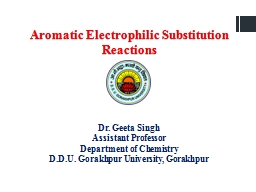

Dr Geeta Singh Assistant Professor Department of Chemistry DDU Gorakhpur University Gorakhpur Introduction Key terms General reaction for aromatic electrophilic substitution Common reactions of AES ID: 1040059
Download Presentation The PPT/PDF document "Aromatic Electrophilic Substitution Reac..." is the property of its rightful owner. Permission is granted to download and print the materials on this web site for personal, non-commercial use only, and to display it on your personal computer provided you do not modify the materials and that you retain all copyright notices contained in the materials. By downloading content from our website, you accept the terms of this agreement.
1. Aromatic Electrophilic Substitution ReactionsDr. Geeta SinghAssistant ProfessorDepartment of ChemistryD.D.U. Gorakhpur University, Gorakhpur
2. IntroductionKey terms.General reaction for aromatic electrophilic substitution.Common reactions of AES.General mechanism of AES Reaction.Energy Profile Diagram.Common AES reactions and their mechanism.Summary.References.CONTENTS
3. INTRODUCTION
4.
5. Generalized ReactionThe reaction takes place on an aromatic ring with the attack of an electrophile which leads to the substitution in the aromatic ring.
6. The five most common aromatic Electrophilic substitution reactions are as follows:
7. TE
8.
9. Energy Profile Diagram: Energy of Ts1 and Ts2 is higher than intermediate, therefore they are less stable.
10. Chlorination: Benzene reacts with chlorine in presence of AlCl3 at room temp. to form chlorobenzeneNOTE: Similarly ,the reaction for bromination also. Iodination and fluorination takes place under very adverse condition. They have different method of preparation .
11. Nitration of an aromatic compound is usually carried out by heating the nitrating mixture (conc. HNO3 and H2SO4).Step-1: Formation of electrophile.HNO3 + H2SO4 NO2 + 2HSO4 + H3OStep-2: Attack of electrophile on benzene ring.NITRATION
12. Benzene reacts with fuming H2SO4 at 120 temp.to give benzene sulphonic acid.
13. SO3 electrophile is formed and attacks on benzene ring to form carbocation , loss of proton takes place and then addition of proton takes place to give the substituted product.Mechanism
14. Benzene reacts with alkyl halides in the presence of AlCl3 to form alkyl benzene.MECHANISM: Formation of electrophile . Electrophile attacks to benzene ring and form carbocation and after the loss of proton alkylbenzene formed. CH3CH2Cl CH2CH3FRIEDEL CRAFT ALKYLATION
15. Benzene reacts with acid chlorides in the presence of AlCl3 to give aromatic ketones.FRIEDEL CRAFT ACYLATION
16.
17. ReferencesOrganic Chemistry (Jonathan Clayden ,Nick Greeves ,and Stuart Warren.)A text book of Organic Chemistry (Arun Bahl and B.S Bahl)Wikipedia
18.